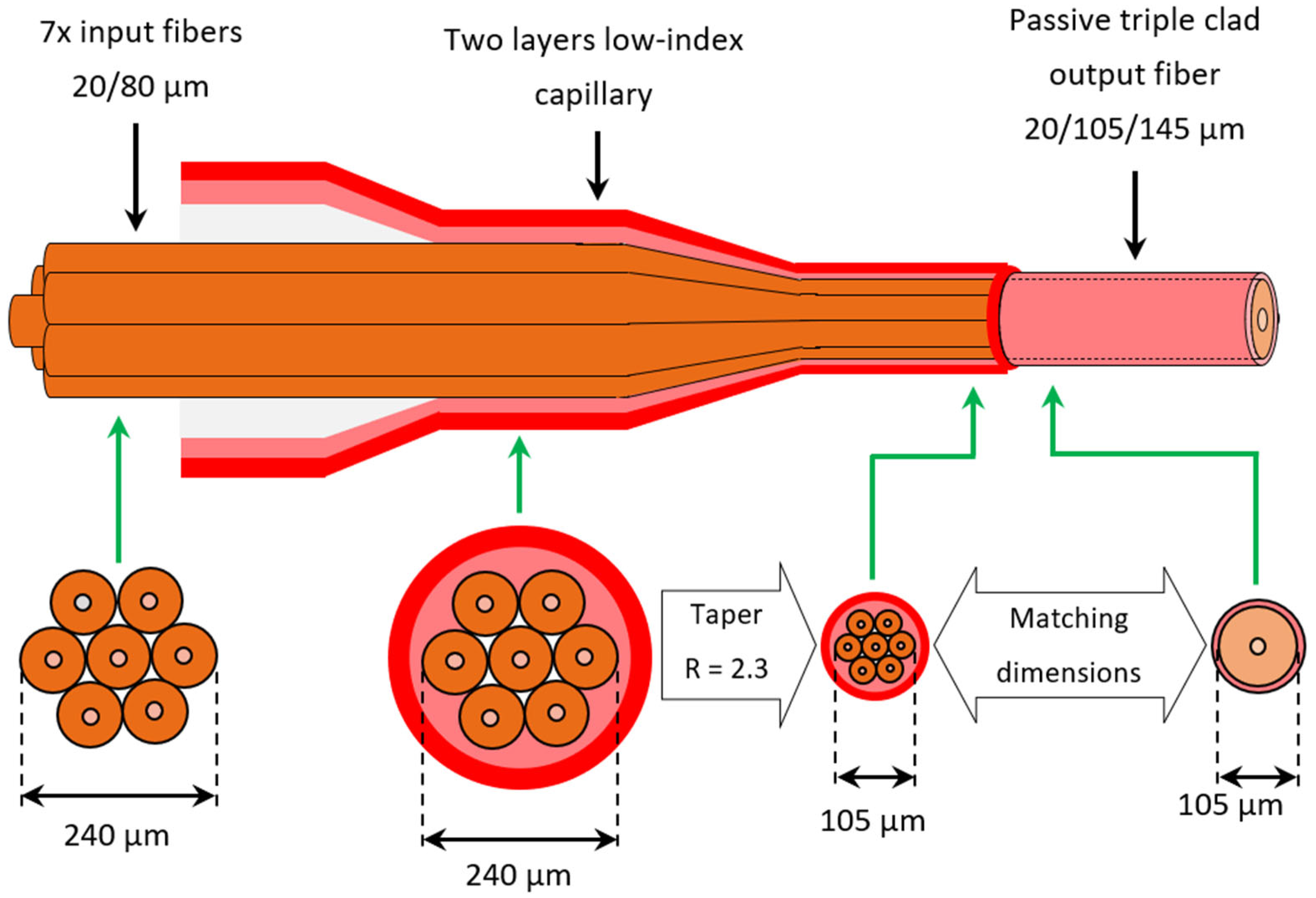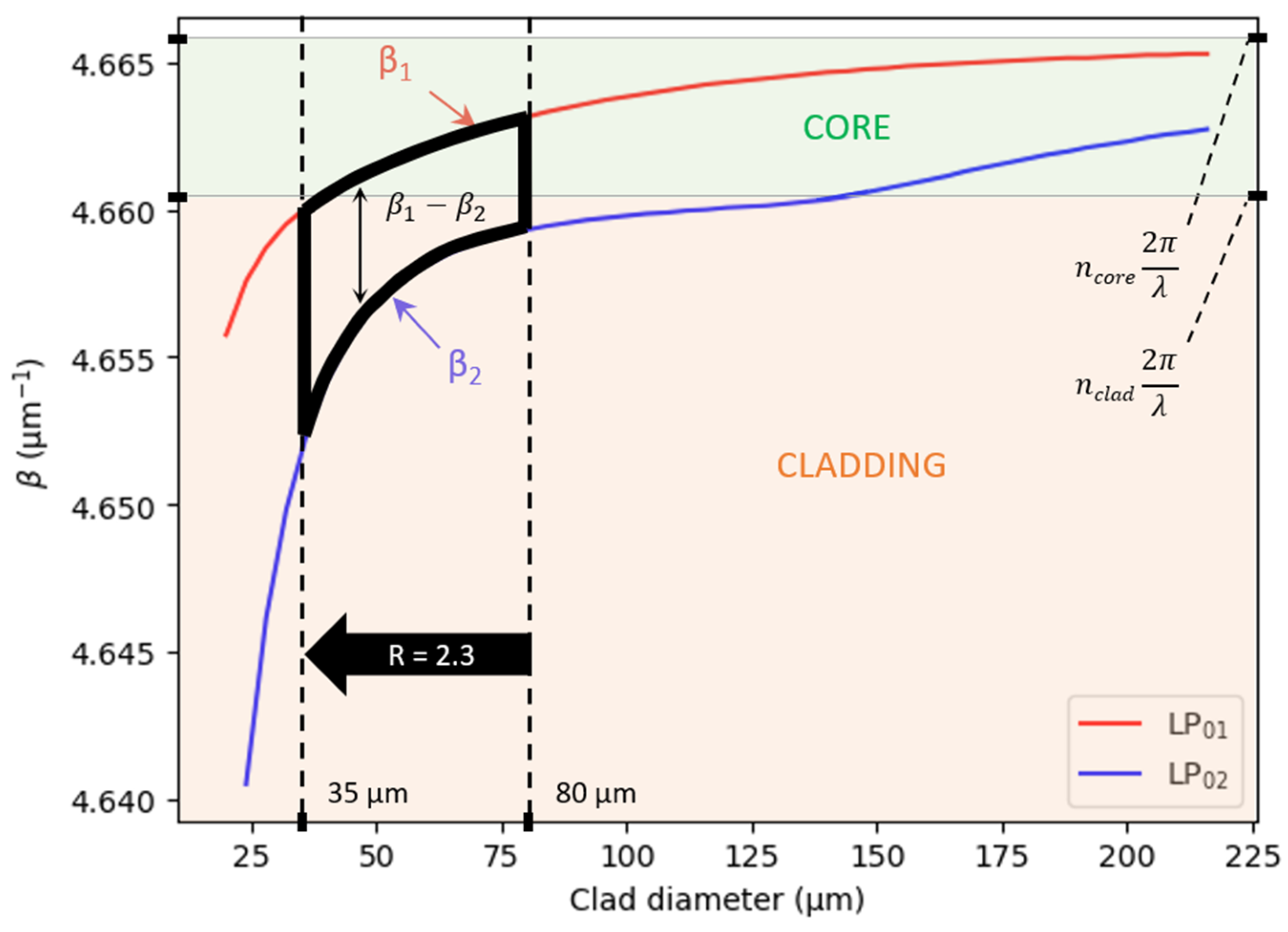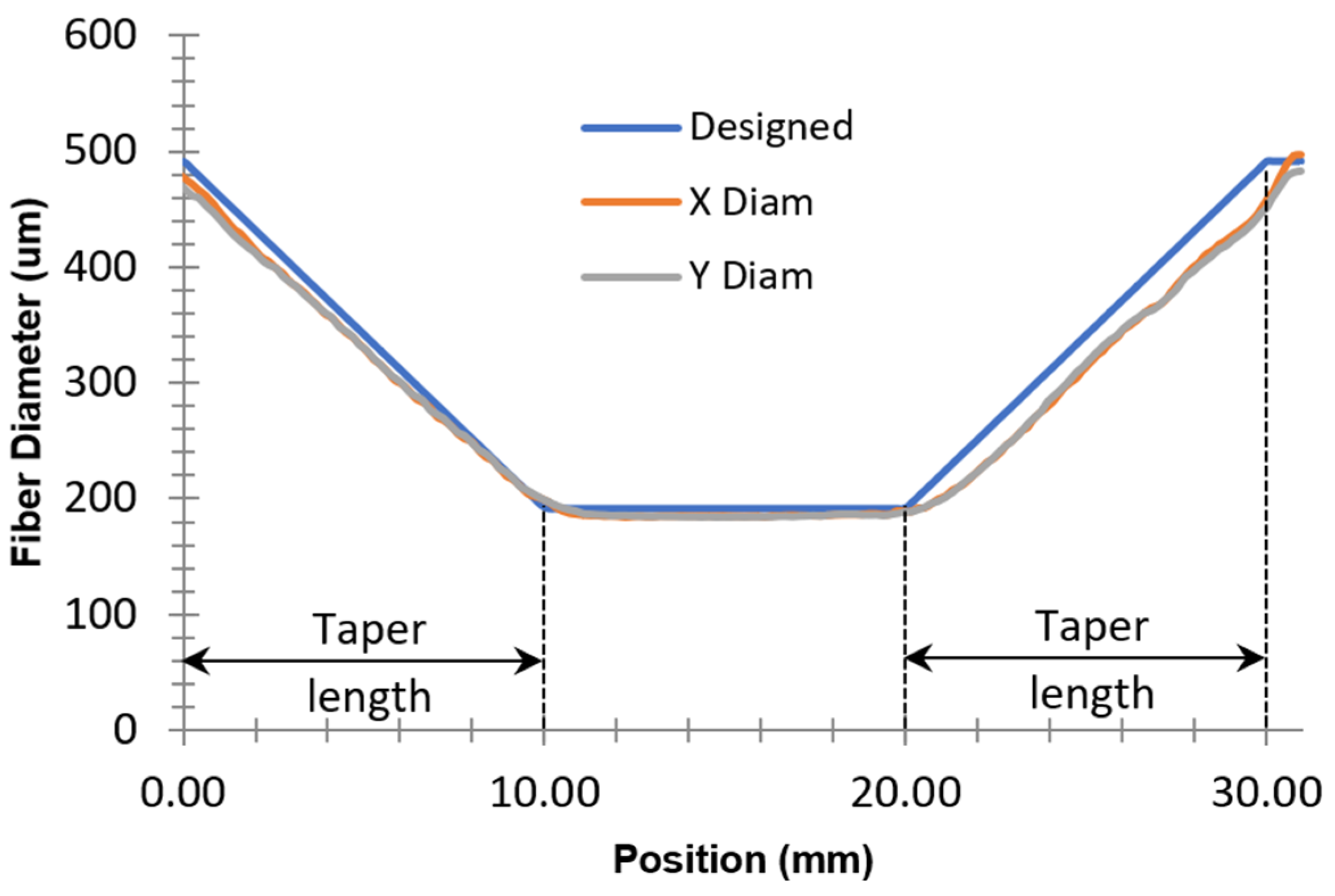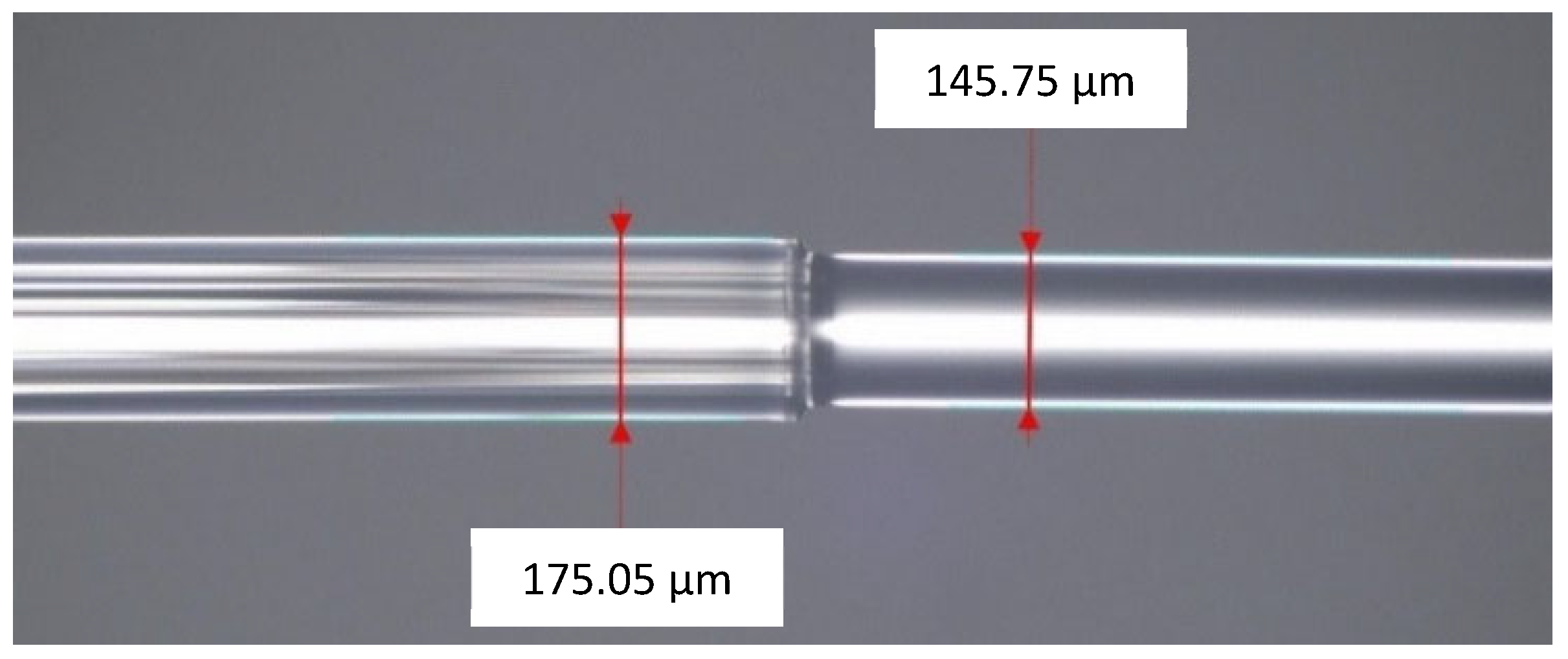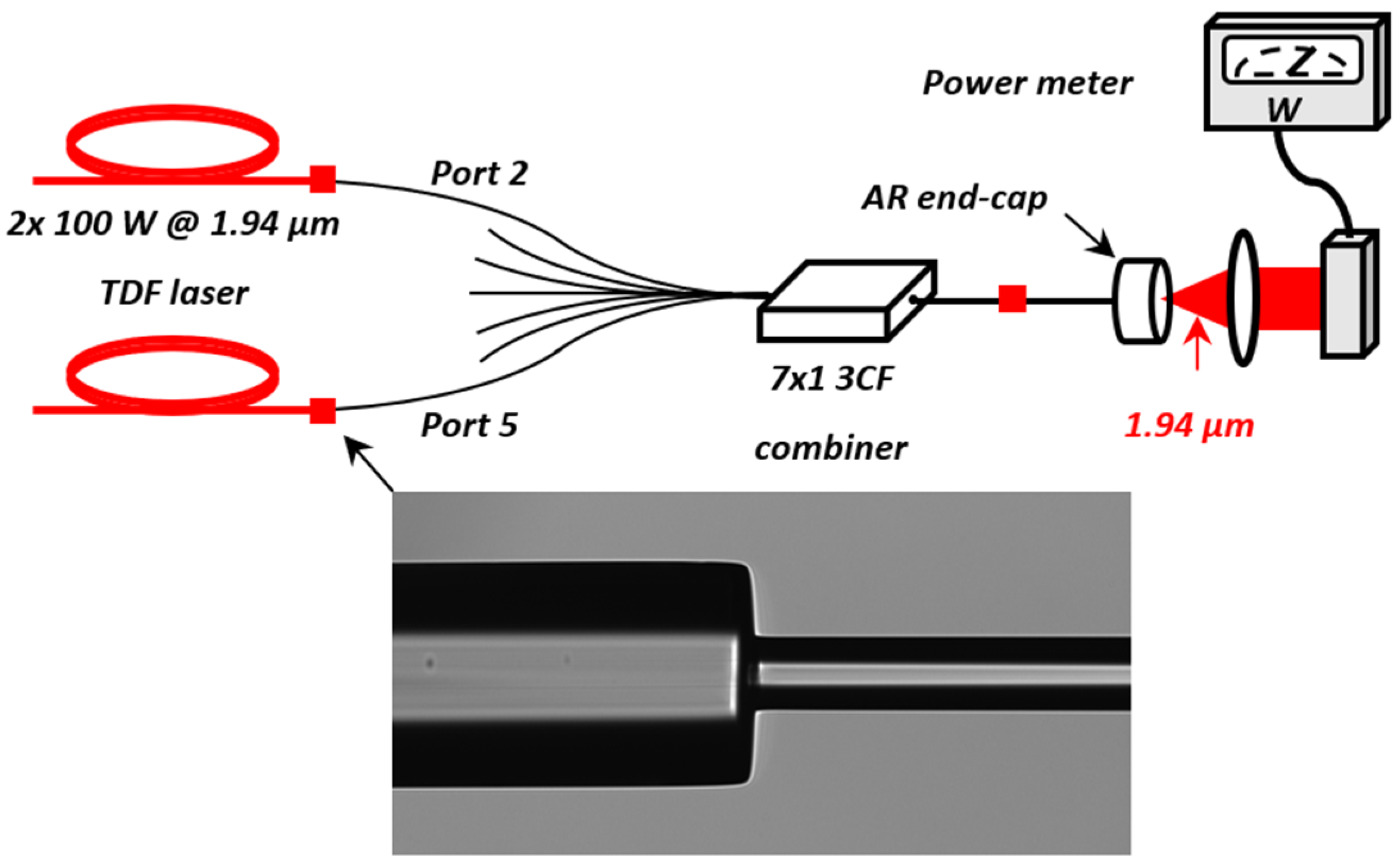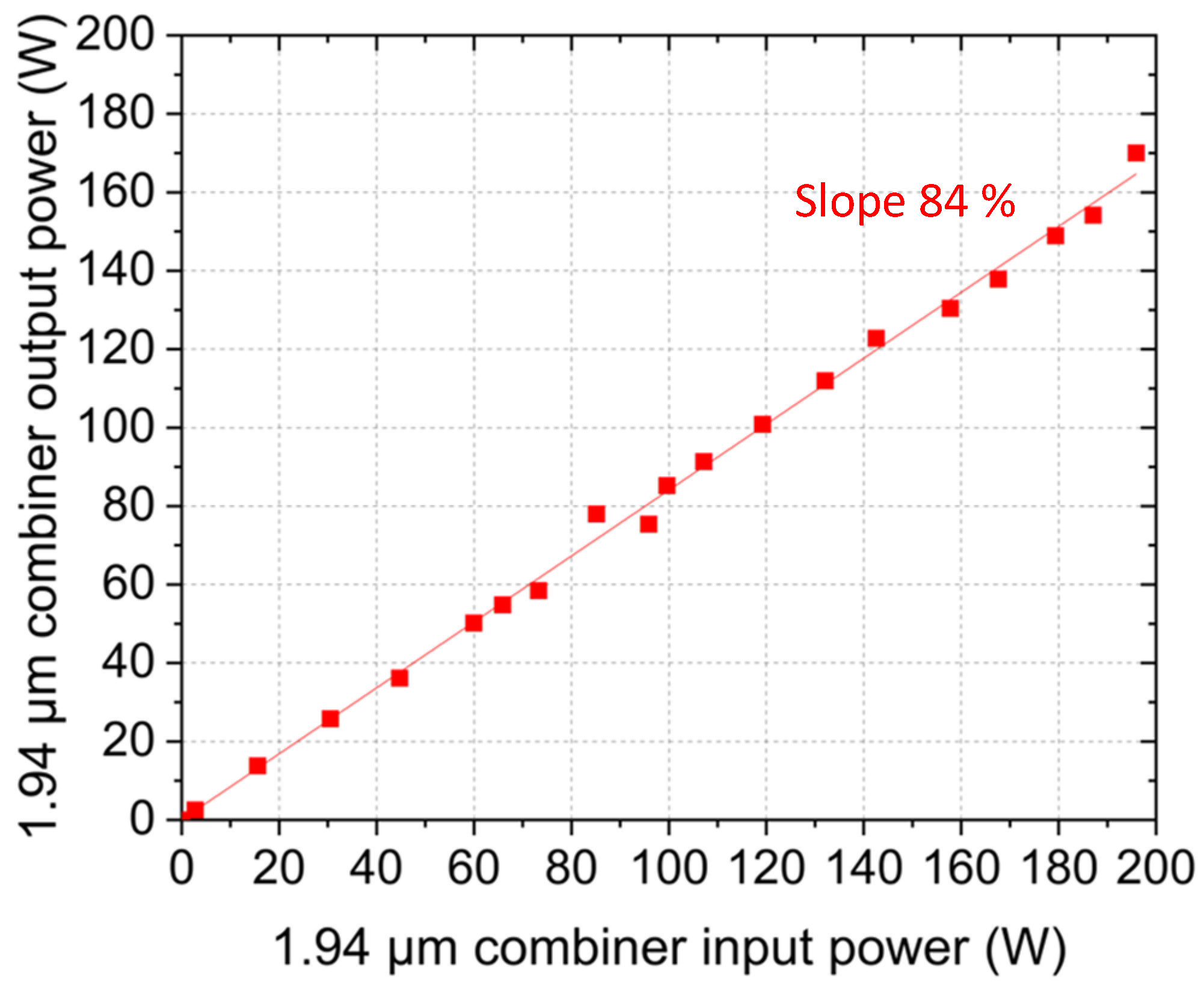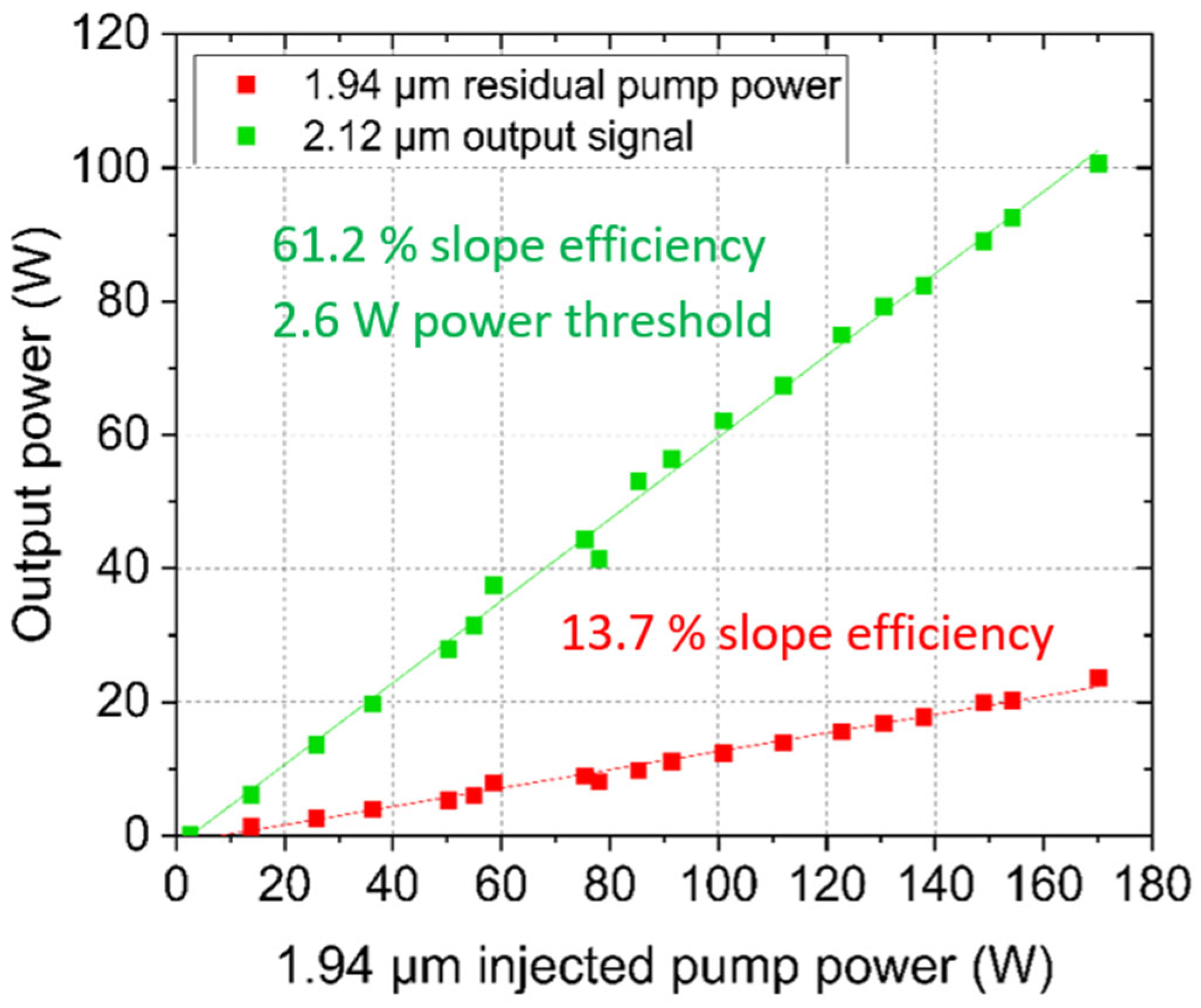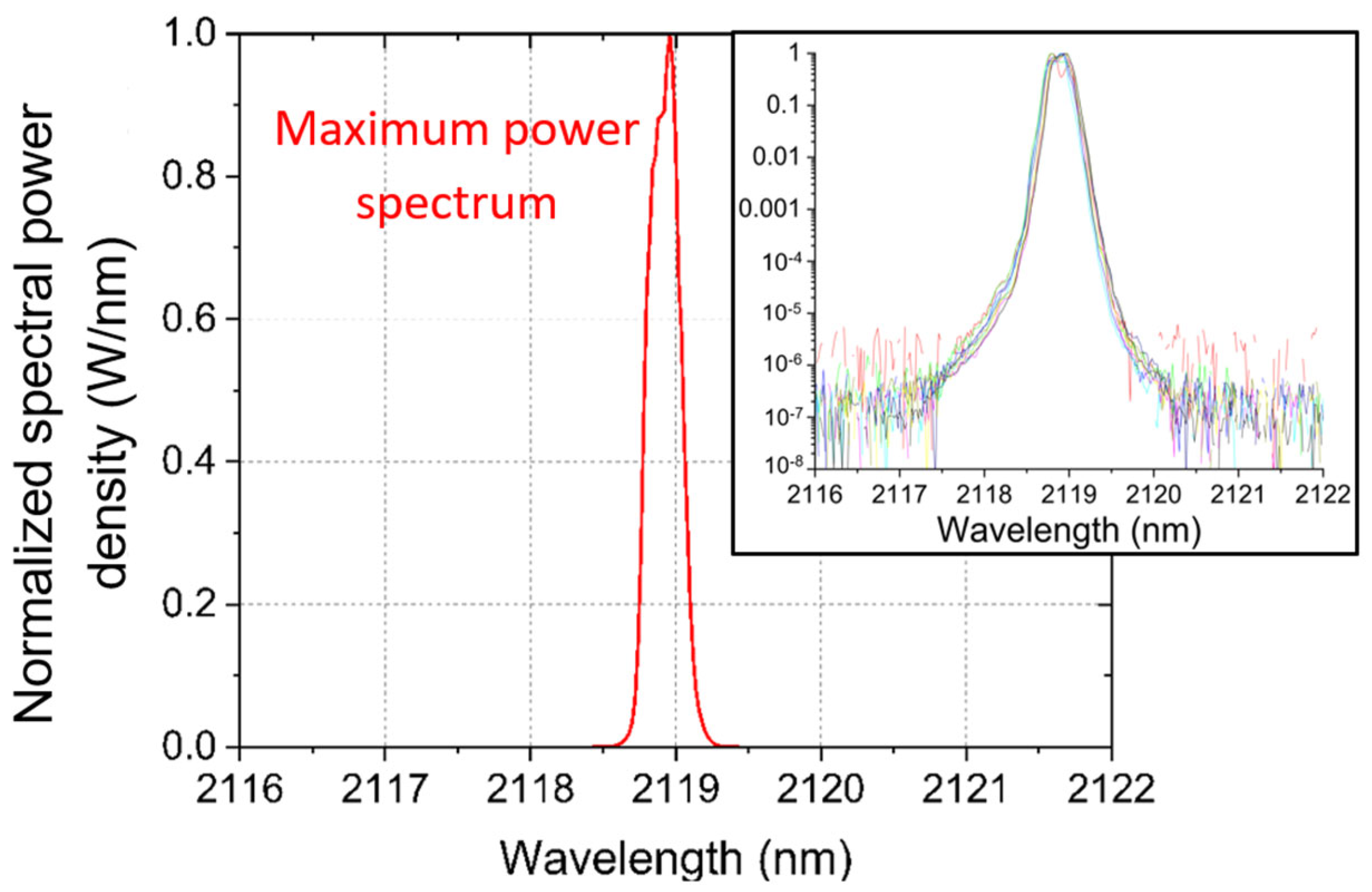2.1. Specific Purpose of the Developed 3CF Pump Combiner
In the work presented in this paper, the main goal of the developed combiner is to demonstrate power scalability from a 2.12 µm triple-clad HDF laser source. By combining the individual CW output powers emitted from several 1.94 µm TDF lasers, the total optical power transmitted by the combiner can be used to resonantly pump at a high level of power the Ho3+ ions doping the core of the active 3CF.
The basic triple-clad HDF laser source architecture investigated and integrating the developed 3CF combiner, is schematically depicted in
Figure 1.
The HDF laser source, schematically represented in
Figure 1, is based on an all-fiber typical single-oscillator architecture. It is composed of seven home-made TDF pump lasers emitting at 1.94 µm a CW output power of typically 100 W each. The output fiber of the seven TDF pump sources is single-clad with 20/250 core/cladding diameters (in micrometers) and a core numerical aperture (NA) of 0.08.
The developed 3CF combiner presented in this paper is used to inject the total pump power coming from the seven 1.94 µm TDF lasers into the cladding of the 3CFs (passive and active) positioned, in the laser setup, after the combiner.
The laser cavity is composed of two triple-clad fiber Bragg gratings (FBGs) developed by exail: one high reflectivity (HR) mirror, reflecting > 99% of the intracavity light at 2.12 µm, and one low reflectivity (LR) output coupler, typically reflecting 5–20% of the intracavity radiation at the same wavelength.
The triple-clad HDF, also developed by Exail, has a Ho3+-doped core of 20 µm diameter (NA 0.08) and a doping concentration of 4 × 1025 m−3. A pure silica pump cladding of 105 µm diameter (NA 0.22) is positioned around the core, itself surrounded by a fluorine-doped low refractive-index cladding of 145 µm diameter. Finally, a two-layer acrylate polymer coating of 265 µm diameter is added to protect the fiber from its external environment.
All the fiber components of the laser architecture represented in
Figure 1 are fusion-spliced together using different stripping, cleaving, splicing and recoating equipment.
2.2. General Structure of the Developed 7 × 1 3CF Combiner
The developed 3CF pump combiner presented in this paper is aimed to be perfectly adapted to the HDF laser presented in
Figure 1. The general structure of the desired 7 × 1 3CF combiner is schematically depicted in
Figure 2.
The 3CF combiner, schematically represented in
Figure 2, is based on a common end-pumping architecture, for which a bundle of several input fibers is tapered and fusion-spliced to the combiner output fiber. This 3CF combiner is composed of seven single-mode input fibers (SMFs) from Exail, with 20/80/160 core/cladding/coating diameters and a core NA of 0.08. These fibers have the same core dimension/NA as the output fiber core of the seven 1.94 µm TDF laser pump sources of
Figure 1 to avoid mode-mismatch losses at the optical splice.
The seven stripped input fibers are inserted in a glass capillary tube, developed by Exail, and composed of two layers of the same thickness: a high refractive index pure silica outer layer and a low refractive index fluorine-doped silica inner one (
Figure 3). The initial dimensions of the glass capillary tube before the tapering process of the fabrication operations (see
Section 3) are 10 cm for the length, 500 µm for the inner hole diameter and 900 µm for the outer pure silica layer diameter.
The inner low refractive index layer of the capillary represented in
Figure 3 has been developed in order to have the capability to propagate toward the combiner output fiber any power leaks coming from the seven internal fibers. The power leaks could take their origin from any default occurring in the fabrication operations, or in case of non-adiabatic properties of the tapering process. The optical guiding properties of the capillary tube can help to obtain a low-loss 3CF combiner, thus ensuring, in principle, its compatibility with power scaling. The low refractive index layer thickness has been chosen to have, after tapering, a final thickness > 10λ (with λ = 1.94 µm). This general rule is commonly applied in multimode fibers to prevent any attenuation through the evanescent field of the light propagating in the multimode core [
9]. It is also the case in the combiner presented in this study, as any 1.94 µm pump light eventually leaking from the core of the seven internal fibers would propagate in a complex and multimode guiding structure presenting a minimum diameter of 105 µm (after tapering).
The output fiber of the developed combiner presented in
Figure 2 is a triple-clad passive fiber manufactured by Exail. This 3CF is a passive version (same dimensions and NA) of the HDF previously presented in
Section 2.1 of this section. It has a germanium-doped silica core of 20 µm diameter (NA 0.08), a pure silica pump cladding of 105 µm diameter (NA 0.22) and a fluorine-doped silica outer cladding of 145 µm diameter. The outer cladding of this fiber is coated with a two-layer acrylate polymer of 265 µm final diameter.
As the input fibers present the same cladding dimensions, the capillary cylindrical symmetry naturally confers a hexagonal arrangement to the seven internal stripped fibers (see bottom images of
Figure 2). Hence, the maximum size of the internal hexagonal structure is 240 µm before tapering (three times the input fiber cladding diameter of 80 µm). As this structure is placed in front of a multimode guide of 105 µm diameter at the output splice of the combiner, it has to be homothetically reduced by a factor of 240/105 = 2.3. This value will be the targeted taper ratio during the tapering process in the manufacturing operations (see
Section 3).
Tapering concern was the motivation for choosing small cladding diameter fibers at the combiner input. Indeed, for a given output fiber and number of input fibers, the bigger the input fibers’ diameter, the higher the tapering ratio. A high tapering ratio of SMFs can lead to a nonadiabatic transition of the light propagating in the tapered section of the fiber. This light leaking from the tapered section is then a source of optical losses and heating for the final combiner. Moreover, a strong homothetical reduction in the diameter of an SMF can induce challenging fabrication conditions to keep symmetry, robustness and easy handling of the tapered fiber. For these reasons, a choice of 80 µm cladding diameter for the combiner input fibers has been made to minimize the tapering ratio and keep the adiabatic properties of the combiner tapered section.
2.3. Adiabatic Tapering Criterion
Adiabatic tapering of an SMF is a gradual and slow homothetical reduction in the fiber dimensions to prevent light from the LP
01 fundamental core mode from being coupled to the first LP
02 higher order cladding mode [
10] (In reference [
10], the SMF is single-clad (high refractive index polymer coating). Thus, no light can propagate in the cladding, and only the LP
01 mode exists and propagates in the core. Nevertheless, for tapering, a short portion of the fiber is stripped and placed in the air. Consequently, the existence of cladding modes is allowed as the bare fiber is surrounded by a low refractive index medium). In this reference, Stachowiak builds a theoretical model for an axisymmetric linear taper of a single-mode bare fiber placed in the air. A condition on the taper length
L to get an adiabatic diameter reduction is then derived and expressed as
where
R is the taper ratio, and
β1 and
β2 are the propagation constants of LP
01 and LP
02 modes of the SMF, respectively.
The adiabatic criterion defined in Equation (1) can be calculated for the combiner presented in this study by numerically determining the propagation constants of the 20/80 SMFs constituting the combiner input ports.
To calculate the propagation constants of the modes of a step-index finite-cladding fiber placed in the air, it is needed to numerically solve the scalar wave equation for the transverse electric field
in the weakly guiding approximation (
ncore ≈
nclad) defined by [
11]:
In Equation (2), r and Φ are the cylindrical coordinates, k = 2π/λ is the wavenumber for the free-space wavelength λ, n is the refractive index profile and β is the propagation constant.
By introducing the effective refractive index
neff defined as
neff =
β/
k, the solutions of Equation (2) will depend on each region of the fiber, i.e., the value of
neff relative to
n. The authors of reference [
11] show that the solutions for
in different regions of the fiber can be written as a combination of Bessel functions of the first and second kind J
ν and Y
ν, and modified Bessel functions of the first and second kind I
ν and K
ν.
Equation (2) can be numerically solved assuming continuity of the transverse electric field
and its derivative d
/d
r at the core-cladding and cladding-air interfaces. For the 20/80 SMFs constituting the input ports of the demonstrated 3CF combiner, the evolution of the propagation constants
β1 and
β2 calculated from our self-written Python (version 3.11) code is plotted in
Figure 4.
Figure 4 shows that the value of the difference (
β1 −
β2), appearing in Equation (1), varies when fiber diameter decreases from 80 µm (original fiber cladding diameter) to 35 µm (final fiber cladding diameter at the end of the taper). Taking the minimum value of (
β1 −
β2) represented in
Figure 4 gives, from Equation (1), a minimum taper length
L for adiabatic tapering of 2.2 mm.
Figure 4 also shows that for an 80 µm cladding diameter, the LP
01 mode is propagating in the core region, whereas the LP
02 mode is a cladding mode. Nevertheless, when the fiber diameter is reduced along the taper, at the end of the taper, the LP
01 mode starts to become a cladding mode (see red curve in
Figure 4 near the 35 µm cladding diameter value). This graph indicates that the 1.94 µm pump power originally propagating in the 20/80 SMF core could propagate in the fiber cladding at the end of the taper section of the demonstrated 3CF combiner.
The authors want to emphasize on the limits of validity of the result obtained in
Figure 4: Equations (1) and (2) have been derived for a single bare fiber placed in the air [
10,
11], whereas, in the demonstrated 3CF combiner, each 20/80 fiber is placed in a much more complex environment. Actually, there are seven fibers arranged in a hexagonal structure, and only the six peripheral fibers are surrounded by a two-layer glass capillary tube whose refractive indexes are significantly different from 1. Therefore, the model used to calculate the propagation constants of a single 20/80 SMF cannot quantitatively describe the modes’ properties of this complex structure. Thus, the adiabatic criterion calculated for the minimum taper length
L may be incorrect. Nevertheless, the calculation performed in this study indicates some possible trends: first, the 1.94 µm pump power originally propagating in the fiber core (LP
01 mode) has, when going through the taper, non-negligible chances to escape from it and propagate in the whole hexagonal structure. This information led to the implementation of a low-index glass capillary in our combiner to direct this pump power to the output fiber, thus limiting optical losses and component heating. Second, the calculated minimum taper length value to get adiabatic properties of a tapered 20/80 SMF (
L ≥ 2.2 mm for
R = 2.3) can be considered as a first rough approximation. In our fabrication operations, the tapering process will be driven with a taper length
L ≫ 2.2 mm.

